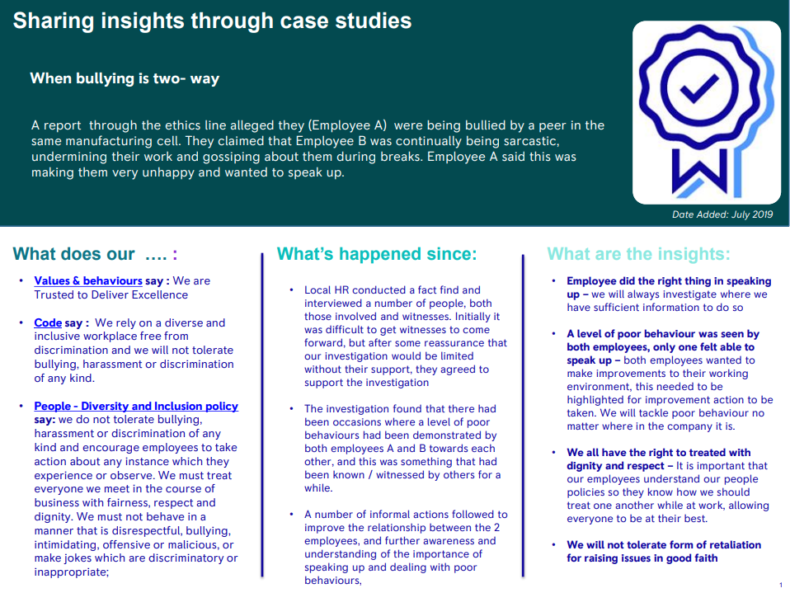Tags: Speak Up, Communication & Engagement, Training
In the first blog of the Innovating Business Ethics series, Steve Kerry, Rolls-Royce plc talks about how they use real-life cases handled by the company and turn them into anonymised stories known as ‘case studies’. This is done in collaboration with HR colleague Tracy Leja. This gives extra ‘power’ to their programmes!
In 2018 we realised we needed to do more to raise awareness and educate employees on bullying, harassment and discrimination and launched a programme called “Treating Everyone with Dignity and Respect”. Since then we have continued to promote and action a range of learning and communication interventions to help move this part of our culture even further in the right direction. Often people think it’s the big one-off communication and learning campaigns that will make the difference but it’s important not to forget that regular, what we like to call ‘drumbeat’, communications/learnings are important too. Case studies are an important part of that ‘drumbeat’.
Our case studies are real-life cases and scenarios we’ve seen and addressed, sourced from both our Speak up channels and directly from our HR colleagues across the company. Tracy and I work together to anonymise the story to ensure we are protecting the privacy and confidentiality of everyone who was involved. We use a standard template we created to help us generate each case study. The key main sections we include in every case study are:
- Background to the story
- Demonstrate the linkages of the story with our values, our Code and relevant Group policy
- Explain what happened next
- Key learnings/insights we can take from the story
To bring this to life, here is an example of one of our case studies:

Every two months we add to the existing bank of case studies, so the bank just keeps getting bigger and bigger. These case studies have given ‘power and weight’ to the ethics and compliance programme and demonstrate the commitment to treating everyone with dignity and respect in a number of ways:
- Makes the invisible, visible. Often when a case is resolved everyone won’t know the outcome due to the privacy and confidentiality of the individuals involved but this allows us to convey actions are being taken.
- We sometimes get feedback from employees who say, “What’s the point in speaking up, nothing ever happens”. We now direct them to look at our case studies to hopefully understand actions are being taken.
- It’s empowering people to speak up. We’ve had people share with us, “I read a case study that was similar to something I had a concern about, and it gave me the confidence to speak up and get my concern resolved”
- It’s a conversation tool our leaders can use. We encourage our leaders to dip into the bank of case studies and use them in conversations with their team.
To date, we’ve had over 6,500 views of case studies and we’ve received feedback from people to say "it’s great to get a level of transparency about what is happening when people speak up" and "it gave me the confidence to speak up". Tracy and I would be happy to connect with you if you’re wanting to find out more about our case studies.
Authors



